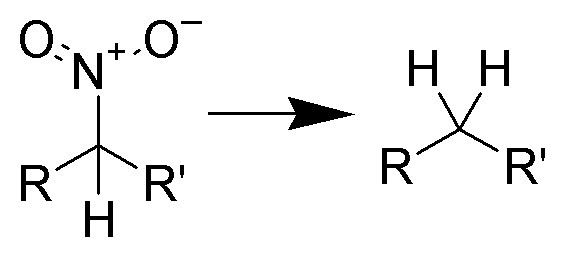 | ||
The chemical reactions described as reduction of nitro compounds can be effected by many reagents and reaction conditions. Historically, the nitro group was one of the first functional groups to be reduced.
Contents
Alkyl and aryl nitro compounds behave differently. Thus, reduction conditions can be broadly classified by starting materials: aliphatic nitro compounds or aromatic nitro compounds. Secondary classifications are based upon reaction products.
Hydrodenitration (replacement of a nitro group with hydrogen) is difficult to achieve but can be effected by catalytic hydrogenation over platinum on silica gel at high temperatures.
Aliphatic nitro compounds can be reduced to aliphatic amines by several reagents:
α,β-Unsaturated nitro compounds can be reduced to saturated amines by:
Reduction to hydroxylamines
Aliphatic nitro compounds can be reduced to aliphatic hydroxylamines using diborane.
The reaction can also be carried out with zinc dust and ammonium chloride:
R-NO2 + 4 NH4Cl + 2 Zn → R-NH-OH + 2 ZnCl2 + 4 NH3 + H2ONitro compounds are typically reduced to oximes using metal salts, such as stannous chloride or chromium(II) chloride. Additionally, catalytic hydrogenation using a controlled amount of hydrogen can generate oximes.
The reduction of nitroaromatics is conducted on an industrial scale. Many methods for the production of anilines from aryl nitro compounds exist, such as:
Metal hydrides are typically not used to reduce aryl nitro compounds to anilines because they tend to produce azo compounds. (See below)
Reduction to hydroxylamines
Several methods for the production of aryl hydroxylamines from aryl nitro compounds exist:
Reduction to hydrazino compounds
Treatment of nitroarenes with excess zinc metal results in the formation of N,N'-diarylhydrazine.
Treatment of aromatic nitro compounds with metal hydrides gives good yields of azo compounds. For example, one could use:
Reduction to azoxy compounds
Aromatic compounds are reduced to azoxy compounds by using:
Na3AsO3 or glucose or NaOHC6H5NO2→